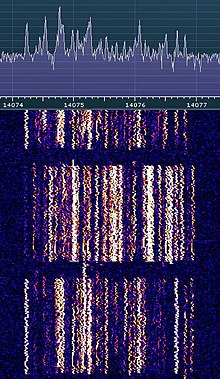This is an old revision of this page, as edited by Riverbend21 (talk | contribs) at 06:31, 30 December 2022 (Reverting edit(s) by 45.117.247.229 (talk) to rev. 1127187711 by Hypergraph: non-constructive (RW 16.1)). The present address (URL) is a permanent link to this revision, which may differ significantly from the current revision.
Revision as of 06:31, 30 December 2022 by Riverbend21 (talk | contribs) (Reverting edit(s) by 45.117.247.229 (talk) to rev. 1127187711 by Hypergraph: non-constructive (RW 16.1))(diff) ← Previous revision | Latest revision (diff) | Newer revision → (diff) Frequency shift keying digital mode
FT8 or Franke & Taylor 8 is a frequency shift keying digital mode which was released on June 29, 2017, by the creators Joe Taylor, K1JT and Steve Franke, K9AN along with the software package WSJT. FT8 is a popular form of digital weak signal communication used primarily by amateur radio operators to communicate on amateur radio bands with a majority of traffic occurring on the HF amateur bands. It is currently the most popular digital mode on spotting networks such as PSK Reporter. The mode offers operators the ability to communicate in unfavorable environments such as during low sun spot numbers, high RF noise, or during low power operations. With advances in signal processing technology FT8 is able to decode signals with a signal to noise ratio as low as −20 dB, which is significantly lower than CW or SSB transmissions. The mode works by sending signals in 15-second-blocks with 12.64 seconds of transmission time and 2.36 seconds of decode time, this gives the mode five words per minutes effective transmission. The mode requires each computer to be synced up in time with each other with most users making use of either NTP or GPS to ensure transmissions fall in the proper window. This allows FT8 transmission to support up to 13 characters, the mode uses forward error correction to ensure proper transmission and decoding. As the mode is quite limited in the number of words that it can send, it only sends enough information to ensure a contact with each station. There are multiple uses for FT8 including contesting, testing antennas, and for scientific research.

References
- ^ Burmester, Dale March 12, 2019. Amateur Radio Digital Communications Mode FT8. http://site.ieee.org/msn/files/2019/04/FT8-KA9SWE.pdf
- Luscre, Anthony (2019-10-11). "FT8—What Is It and How Can I Get Started?". OnAllBands. Retrieved 2022-08-17.
- Barron, Robert (2020-02-08). "PSK Reporter". KA5WSS. Retrieved 2022-10-06.
- "FT8 – Signal Identification Wiki". www.sigidwiki.com. Retrieved 2022-08-17.
- "FT8 Mode is Latest Bright Shiny Object in Amateur Radio Digital World". www.arrl.org. Retrieved 2022-08-17.
- "FT8/FT4 from a contester's perspective – VA7ST.ca". Retrieved 2022-08-17.
- "ARRL Surveying Field Day Participants". www.arrl.org. Retrieved 2022-08-17.
- "FT8". www.rtl-sdr.com. Retrieved 2022-08-17.
- Erickson, P.; Liles, W.; Miller, E.; Miller, E. (2020). "Amateur digital mode based remote sensing: FT8 use as a radar signal of opportunity for ionospheric characterization". hamsci.org. Retrieved 2022-08-17.